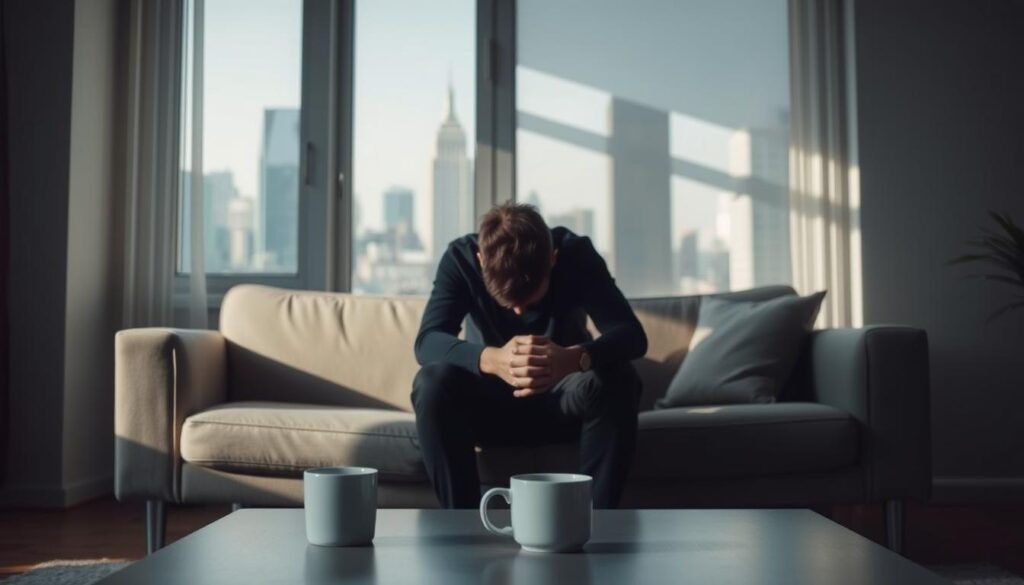About 15 million adults in the U.S. battle Social Anxiety Disorder (SAD). This issue hits women harder than men. Knowing the signs of social anxiety is key. It helps offer the needed support, as it greatly affects life. This includes relationships, work, and daily activities.
Social anxiety is when someone fears and avoids social settings. They worry others will judge them harshly. Catching this early and getting treatment like therapy or medicine helps a lot. People with social anxiety might feel tense, have a fast heartbeat, or breathe quickly. They also believe negative things that make socializing hard. This guide aims to pinpoint these signs and provide insight into managing the disorder.
Key Takeaways
- Social Anxiety Disorder primarily affects women more than men.
- Recognizing signs of social anxiety can help in earlier diagnosis and treatment.
- Physical symptoms like muscle tension and rapid heartbeat are common among individuals with SAD.
- Cognitive Behavioral Therapy (CBT) is a highly effective treatment option.
- Support groups can provide essential community and assistance to those dealing with SAD.
Understanding Social Anxiety Disorder
Social anxiety disorder, or SAD, means being very afraid of being judged in social situations. People usually start feeling this way in their teens, but it can begin earlier or in adulthood. They might get super anxious in situations like speaking in public, going to job interviews, or meeting new people.
There’s a type of SAD that’s all about fear of speaking or performing in public. Other social scenes might not be as scary. Symptoms include blushing, sweating, and a fast heartbeat. These can make it hard for someone to join in socially. About 15 million adults in the U.S. have this disorder, and it’s more common in women.
If not treated, social anxiety disorder can last a long time. It can really affect someone’s life, work, and friendships. Many people don’t seek help because they think their anxiety is just part of who they are. But treatments like cognitive behavioral therapy (CBT) can make a big difference. Other helpful treatments include exposure therapy and acceptance and commitment therapy (ACT), which help people face their fears and feel less anxious.
This disorder can range from mild to very severe. It can even cause worry about social events before they happen. Understanding this condition is crucial for helping someone with social anxiety disorder.
Common Social Anxiety Symptoms
Social anxiety disorder affects about 15 million adults in the United States. It usually starts in the early to mid-teens. This condition leads to difficulty in social situations. People with it often struggle with daily life due to common social anxiety symptoms.
Feelings of intense fear or anxiety in social settings are common. Many feel very self-conscious. They worry about being judged or embarrassed. This fear creates a cycle of distress, especially when facing social events.
People might avoid social gatherings, not engage in conversations, or skip public activities. Avoiding situations like eating out or using public bathrooms is also common. These are key signs of social anxiety.
Physical symptoms also occur, adding to the difficulty. These can include a fast heartbeat, sweating, dizziness, and more. Such symptoms show the body’s intense stress response in social situations.
There are ways to help those with social anxiety disorder. Cognitive behavioral therapy (CBT) is one effective approach. It usually involves 8 to 12 sessions. Medications like antidepressants and beta-blockers may also help. Yet, many hesitate to seek treatment.
Knowing the symptoms of social anxiety is important. It helps those affected to seek support and manage their anxiety. For more on this topic, visit this article.
Emotional and Behavioral Indicators
It’s vital to know the emotional and behavioral signs of social anxiety. Many people face intense fear in social situations. These signs appear in various ways, making people anxious and avoidant.
Fear of Judgment
Feeling judged is a common sign of social anxiety. This fear stops people from being social. They overthink their interactions and imagine the worst.
This fear stops them from enjoying life and connecting with people. It hurts both personal and work relationships.
Worrying About Embarrassment
Another big worry is the fear of embarrassment. People with social anxiety think they’ll act foolishly. This worry makes their anxiety worse.
It also makes them feel bad about themselves. Seeing this pattern is key to getting help and understanding one’s feelings better.
Avoidance of Social Situations
Avoiding social events is a clear sign of social anxiety. Many people try their best to avoid being social. They miss out on events and invitations.
This avoidance leads to loneliness and more anxiety. But getting help can change this. Treatments like Cognitive-Behavioral Therapy are helpful.
Recognizing Signs of Social Anxiety
Detecting signs of social anxiety means knowing the physical and behavioral clues people show. It’s key to help and support those who find social situations hard. This part talks about important signs that point out this disorder.
Physical Symptoms to Look For
People with social anxiety often have physical symptoms. These can change how they act every day. You might see symptoms like:
- Blushing
- Trembling or shaking
- Rapid heartbeat
- Shortness of breath
- Sweating a lot
- Upset stomach or feeling sick
- Dizziness or feeling light-headed
- Fainting or almost fainting
These signs can be stronger in scary situations, like speaking in public or meeting new folks. Knowing these signs helps understand social anxiety’s impact on socializing.
Social Behavior Red Flags
There are also behavioral signs of social anxiety. Watching how someone acts can show if they’re struggling with social scenes. Some behavioral signs are:
- Avoiding social events if they can
- Keeping quiet or not joining in talks
- Taking a friend to social events for support
- Talking too much or showing distracting behaviors
- Using alcohol to feel at ease in social places
Spotting these behaviors is a step to seeing social anxiety signs. It urges people to get help or find ways to cope. Support from loved ones or pros is crucial for those dealing.

Identifying Social Anxiety Cues in Children
Social anxiety shows up in kids in many ways. It’s vital for parents and teachers to spot these early signs. Knowing what to look for helps them support kids better. They can create a caring space by understanding these cues.
Behavioral Signs in Children
Kids with social anxiety might act differently. They might not want to join in with friends. Or they could cry or get upset in social places. Some might stay very close to someone they trust.
They may worry a lot about what others think. Or they avoid eye contact and speak quietly. These behaviors show they might be feeling anxious.
Physical Reactions to Social Situations
Kids also have physical signs when they’re anxious. They might shake or tremble when they have to talk or meet someone.
They could have a fast heartbeat when around others. Or complain about stomach aches or headaches before events. They might hide or not talk when they’re nervous.
Spotting these signs early is crucial. Parents and teachers need to watch for these behaviors and physical signs. They can then help kids feel supported. This lets kids grow and learn how to handle their feelings better.
Understanding the Causes of Social Anxiety
Social anxiety disorder (SAD) is influenced by genetics and life experiences. The causes of social anxiety come from our genes and what we go through in life. Understanding these parts helps us see how social anxiety starts and stays with someone.
Inherited Traits and Family History
Studies have found that genes are a big factor in social anxiety. If a close family member has SAD, you’re much more likely to have it too. Heritability rates for SAD are between 27% and 56%. This shows genes play a key role. Also, kids who are very shy may have a higher chance of getting social anxiety later.
Environmental Factors and Negative Experiences
Environment and experiences are just as crucial as genetics in developing social anxiety. Bullying, embarrassment, and negative interactions can deeply affect someone. How parents act and cultural norms also influence how kids handle social situations. By understanding these social phobia characteristics, we see how outside experiences greatly affect social anxiety.
To really get the root causes of social anxiety, we need to see how these elements interact. This makes the disorder complex in both how it appears and how we treat it. A thorough approach is essential for truly understanding and tackling SAD.
Risk Factors for Developing Social Anxiety
Understanding why some people get social anxiety is important. Personality and changing social situations play a big part. Knowing these reasons helps us understand how social anxiety starts.
Shyness and Temperament
Being shy is a big factor in social anxiety. Those who are naturally shy or keep to themselves may be more at risk. Their shyness can stop them from being social and make them worry about being judged or feeling embarrassed.
Being very self-conscious can make these feelings worse. This leads to avoiding social situations.
New Social Demands and General Characteristics
New social situations can make social anxiety worse. For example, starting high school or college is a big change. It puts teens in new social situations and adds stress. This can make social anxiety disorder more likely.
Having a speech issue or overprotective parents can also increase the risk. These factors can lower social confidence and make feelings of not being good enough worse.
Complications Associated with Social Anxiety
Social anxiety disorder can lead to serious complications of social anxiety if not addressed. Its effects touch many parts of everyday life. It’s vital to understand these complications to get help on time.
Impact on Daily Life
The impact of social anxiety on life is deep. People with social anxiety have trouble with relationships. This affects both their personal and work lives. They might face:
- Difficulties in forming close relationships and friendships
- More isolation or avoiding social events
- Higher chances of failing in school or dropping out
- Challenges in starting or advancing their careers
- Poor self-esteem and limited personal development
Not dealing with social anxiety can make life harder, damaging well-being. Early help can ease social struggles.
Co-occurring Mental Health Disorders
Social anxiety often appears with other mental health problems, like major depression or substance abuse. This shows why it’s crucial to treat the whole picture. The risks include:
- Suicidal thoughts are more common in those not managing their social anxiety
- Turning to alcohol or drugs to cope
- Also having issues like generalized anxiety disorder and depression
Overlooking these signs can make complications of social anxiety worse. Thus, making recovery harder. Treatments like cognitive behavioral therapy could significantly improve one’s quality of life.

Those affected must realize the importance of getting help. Starting early can stop bad outcomes and help build better coping skills. For tips on handling and treating social anxiety, see the advantages of therapeutic methods here.
Treatment Options for Social Anxiety
Treating social anxiety means using a mix of options tailored for each person. Psychotherapy is key in helping individuals learn how to cope better and lower their anxiety over time. We’ll look into psychotherapy, medication, and support systems here.
Psychotherapy Approaches
Cognitive Behavioral Therapy (CBT) is the top method for treating anxiety. It helps change the negative thoughts and actions that fuel social anxiety. In therapy, people learn how to handle their anxiety. They get to practice dealing with the situations that scare them, improving their coping skills.
Teletherapy has become a popular way to get therapy easily and privately. It’s especially good for people with social anxiety, making it easier for them to take part in therapy from home.
Medication Options
Sometimes psychotherapy isn’t enough and medication is needed too. SSRIs, like paroxetine (Paxil) and sertraline (Zoloft), are usually tried first for strong social anxiety symptoms. If SSRIs don’t work, then SNRIs like duloxetine (Cymbalta) or venlafaxine (Effexor XR) might be next.
Benzodiazepines are for quick anxiety relief but have a risk of dependence. Beta blockers can help with the physical symptoms of anxiety in situations such as public speaking.
Finding the right medication can take time. Doctors often try several options to find the best one with the least side effects. They start with a small dose and adjust as needed for the best results.
Support Groups and Community Resources
Support groups are very important for dealing with social anxiety. They offer a safe place to share experiences and tips, and get support from others who understand. Workshops and programs in the community offer more ways to get help and learn new skills for managing social anxiety.
| Treatment Option | Description | Effectiveness |
|---|---|---|
| Cognitive Behavioral Therapy (CBT) | Focuses on changing negative thought patterns and behaviors | Highly effective for social anxiety |
| Selective Serotonin Reuptake Inhibitors (SSRIs) | Commonly prescribed antidepressants for social anxiety | First-line treatment |
| Serotonin-Norepinephrine Reuptake Inhibitors (SNRIs) | Alternative medications if SSRIs are ineffective | Moderately effective |
| Benzodiazepines | Short-term relief of anxiety symptoms | Risk of habituation and sedation |
| Support Groups | Peer support for sharing experiences and strategies | Helpful in emotional support |
Self-Help Strategies for Managing Social Anxiety
For those with social anxiety, self-help strategies are key. They help improve emotional well-being. Plus, they make coping with daily social anxiety easier.
Journaling and Reflection
Journaling helps people understand their social anxiety better. By writing down thoughts, feelings, and reactions, patterns emerge. This brings insights into what triggers anxiety. Through reflection, one can counter negative thoughts. This increases self-awareness and aids in making a plan to handle social anxiety.
Setting Realistic Goals
Setting small, achievable goals boosts confidence in social settings. Breaking big goals into easier steps helps lessen the feeling of being overwhelmed. Starting with attending a small event can be a good step. It gets easier with practice. Knowing that being perfect isn’t needed reduces the stress of facing social fears gradually.

Other helpful tips include doing deep breathing for five minutes to ease anxiety. Staying active, eating well, and cutting down on caffeine boosts mental health. These tips are great for mild to moderate symptoms. They are helpful when access to professional help is limited. Yet, seeing a doctor is crucial for severe anxiety to get the right support.
| Strategies | Description |
|---|---|
| Journaling | Writing about feelings and triggers to gain clarity and challenge negative thoughts. |
| Goal Setting | Establishing realistic, achievable goals to gradually expose oneself to social situations. |
| Breathing Exercises | Practicing deep breathing to alleviate anxiety in high-stress moments. |
| Healthy Lifestyle | Incorporating regular exercise and a balanced diet to enhance overall well-being. |
| Reflection | Evaluating past experiences to learn and adjust future social interactions. |
Using these self-help methods improves handling social anxiety. It leads to a more enjoyable social life.
Conclusion
Spotting signs of social anxiety is key to help and understand those with it. It affects about 13% of people, starting in childhood or the teen years. Making more people aware of social anxiety helps fight the stigma. This lets people get help early on.
Treatments for social anxiety include therapy and self-help methods. They help people handle symptoms and enjoy life more. It’s vital to start helping early. Sadly, many wait over 10 years to seek help. For tips on spotting social anxiety, check out this useful link.
We need to make a safe space where talking about and getting help for social anxiety is normal. This can lead to better relationships, higher self-esteem, and a happier life. With support and the right resources, managing social anxiety becomes doable. This helps people do well in their personal and work life.